Trends: Knicks' nightmarish season producing historically bad results
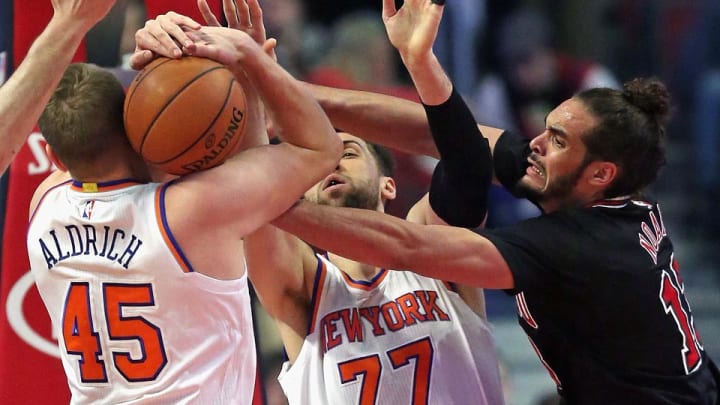
It's not often that "worst season in franchise history" undersells a team's futility, but this year's Knicks outfit has been one for the ages.
Not only has New York (14-60) clinched the most losses since the franchise was founded in 1946, even though there are still two-plus weeks remaining in the season, the Knicks' stretch run has arguably been more dreadful than the late-season struggles endured by the 2014 Sixers (who lost 26 straight games, tying an NBA record) and the 2012 Bobcats (owners of the worst winning percentage in NBA history).
The "How did this happen?" is not really in question. After "racing" to a 2-1 start, the Knicks had racked up losing streaks of seven, 10 and 16 games by mid-January, as first-year coach Derek Fisher struggled to implement the Triangle and was unable to coax anything resembling defense out of his rag tag roster after an ill-advised offseason trade sent Tyson Chandler to the Mavericks.
In short order, All-Star forward Carmelo Anthony was shut down for the season after undergoing knee surgery, J.R. Smith and Iman Shumpert were shipped to the Cavaliers in a salary dump, Samuel Dalembert was released, Amar'e Stoudemire joined the Mavericks after getting released, and Pablo Prigioni was traded to the Rockets. President Phil Jackson's remaining roster pieces, as a collective, were lacking in just about every desirable quality: experience, talent, three-point shooting, rim protection, you name it.
As New York limps to the finish line, the "How bad, exactly, has it gotten?" question is worth an extended look. Although it really doesn't take Jerry West's brain or a six-hour Synergy session to realize that a starting lineup of Shane Larkin, Langston Galloway, Lance Thomas, Lou Amundson and Andrea Bargnani probably isn't lighting the world on fire, Jackson's tanking masterpiece might still be underappreciated.
• MORE NBA: Power Rankings | Thunder's cloudy future |Playoff picture
Phil Jackson asks Knicks season-ticket holders to 'remain optimistic'
All of the key elements for ping pong chasing are in play—a fire sale, a youth movement, injuries, plenty of 10-day contracts and D-League call-ups, a coach who isn't exactly inspiring his troops to overachieve, a loose leash for management thanks to a recent front-office change—and the end result has been as horrific as Jackson could have hoped. New York currently holds a two-game lead on Minnesota for the best odds to win the lottery, putting it in pole position in the race for Karl-Anthony Towns or Jahlil Okafor.
"We will rebuild a team that fits together," Jackson promised on Twitter this week. "Guys that want to compete and play the way [the basketball] gods approve. #GroundUp"
"#SixFeetUnderGround" would have been more appropriate. Let's take a look at the Knicks' mess.
The fall off
When New York traded Smith and Shumpert to Cleveland back in January, SI.com noted that the move took the Knicks from "unintentionally terrible territory to intentionally terrible." Boy, did it ever.
Here's a look at how the NBA's 10 worst teams at the All-Star break have performed since.
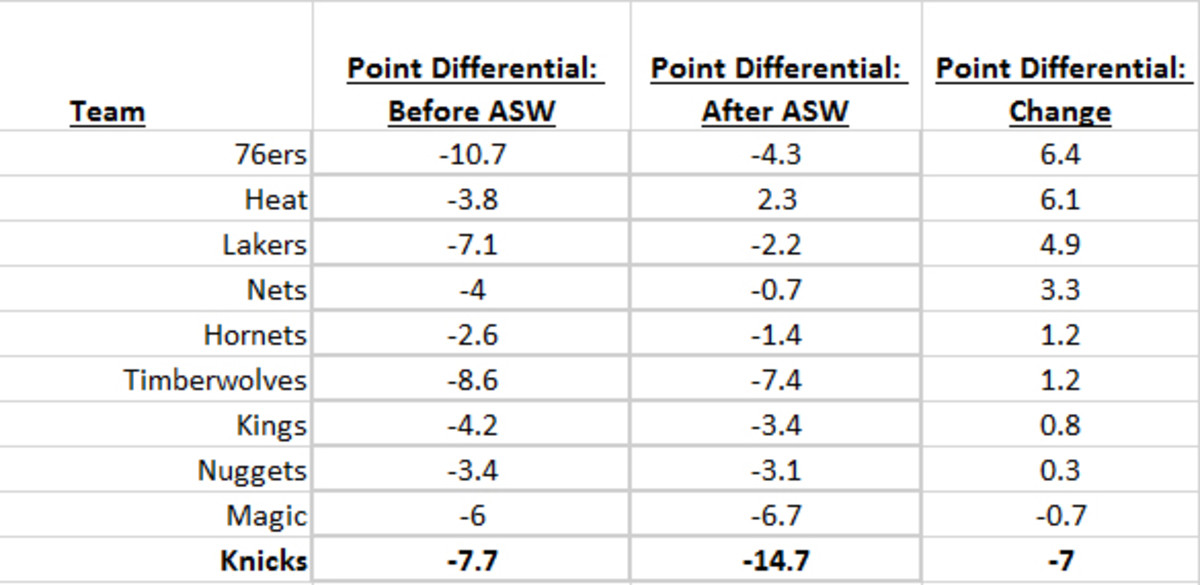
Entering All-Star Weekend, New York (-7.7) was only the league's third-worst team by point differential, besting both Minnesota (-8.6) and Philadelphia (-10.7). Since the break? New York has absolutely smoked the competition in the race to the bottom. The Knicks' post-All-Star break point differential of -14.7 is leaps and bounds worse than the Timberwolves (-7.4) and the Magic (-6.7), who are second-worst and third-worst, respectively.
The staggering plummet can really be seen in the point differential change. Of the 10 worst teams at the All-Star break, eight have played better since the break. This makes some sense: identities have formed, rotations have solidified, coaches have been fired (in a few cases), scheduled have had a chance to even out, and young players have had the chance to improve.
The story has been the exact opposite for the Knicks, whose point differential has plummeted by seven full points. The only other team in this group that has played worse since the break? The Magic, who fired coach Jacque Vaughn in early February and have fallen off only marginally (a -0.7 drop).
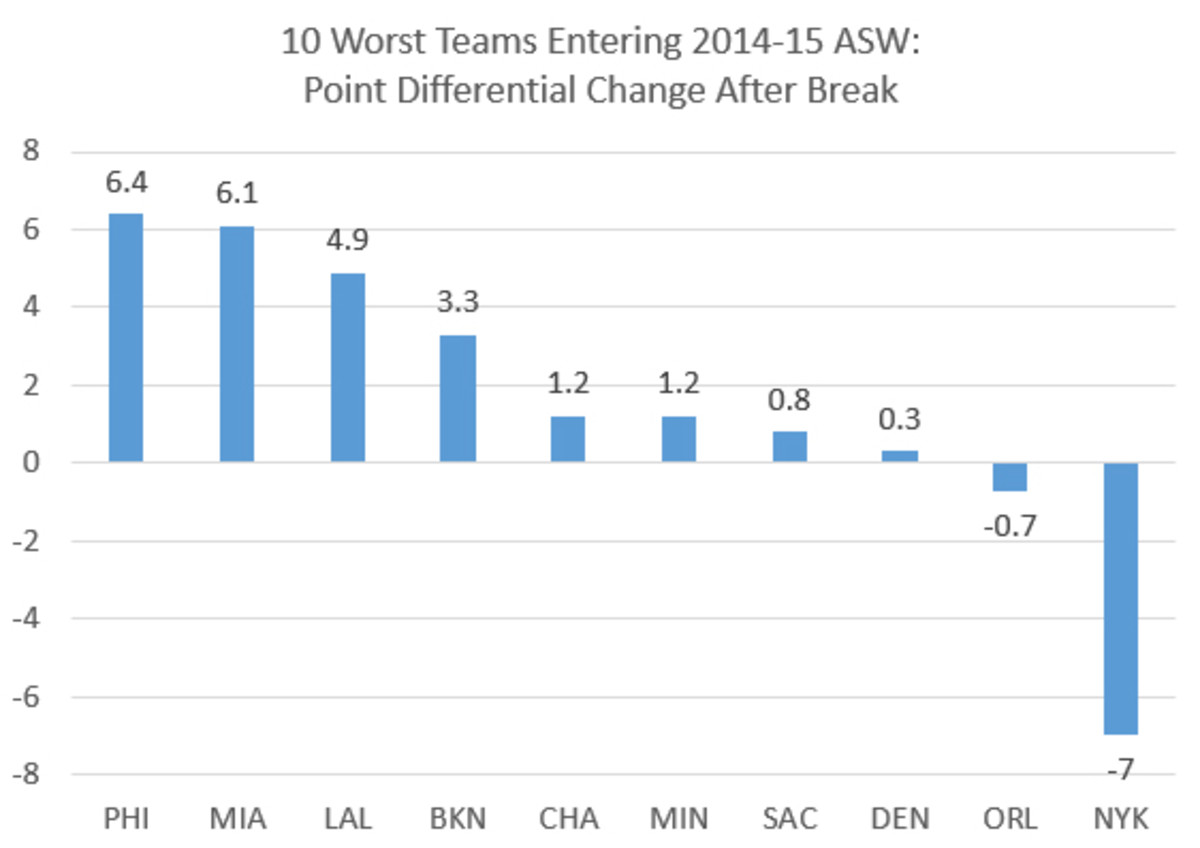
To quickly recap: eight of the 10 worst teams at the All-Star break have gotten at least slightly better since the break, the Magic have tripped over a street curb, and the Knicks have donned a Go Pro camera on their heads before freefalling from a second-floor window into a trash dumpster.
Here's one last chart to reinforce just how far off the map the Knicks' post-ASW point differential has been been compared to the rest of the league. Click here for full size.
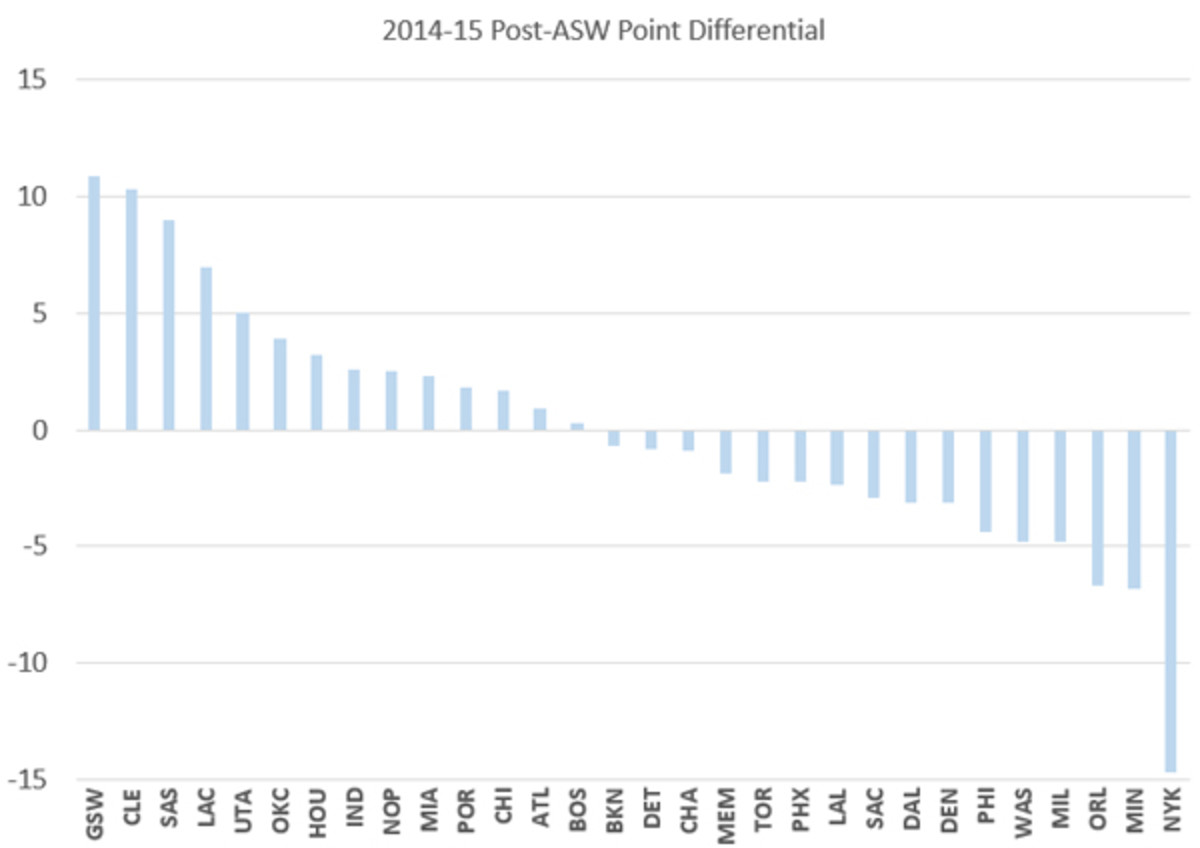
Click here for full size.
Stretch-run struggles
Clearly, a -14.7 point differential after the All-Star Weekend is awful. But how awful? So awful that it is unprecedented during the post-Michael Jordan era.
NBA.com's statistics database tracks post-ASW point differential back to the 2000-01 season, and the Knicks are currently on pace to have the worst mark recorded during that time period. How low can the Knicks go when it comes to stretch-run struggles? Lower than the seven-win 2012 Bobcats (lockout season), lower than the 12-win 2010 Nets who lost 18 straight to start the year, and lower than last year's Sixers, who didn't win a single game between Jan. 30 and March 28. Lower than all of them.
Here's a look at the 10 worst post-ASW point differentials of the last 15 seasons, with the Knicks currently "leading" the way.
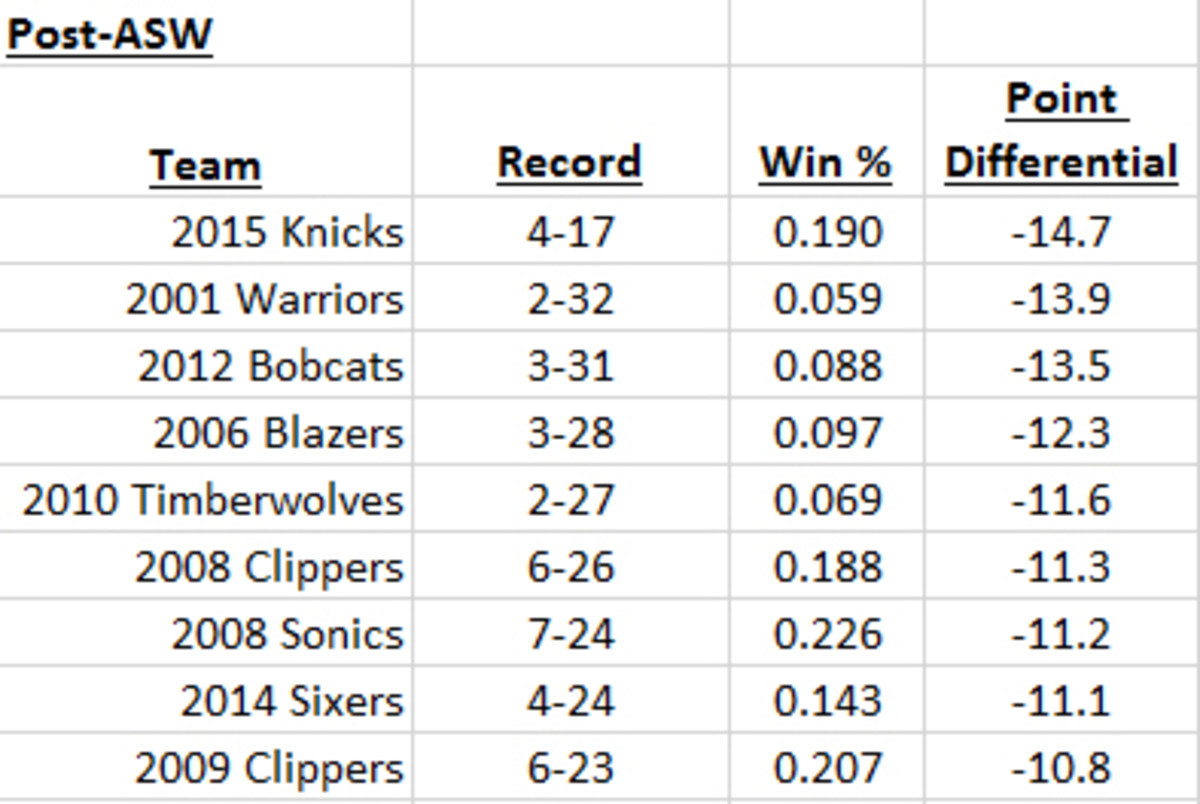
If there's any good news for New York here, the relative weakness of their remaining schedule might help them avoid finishing with the worst post-ASW point differential of the last 15 years. All eight of New York's remaining games come against the East, with only two of those games coming against teams with records above .500. One of those two opponents, Atlanta, might even be resting key players when they visit New York on April 13. Finishing the season on a "high note" is impossible, but Fisher and company do have a pretty nice chance to tidy up their record and point differential before summer arrives.
Phil Jackson's black eye
Perhaps the most remarkable aspect of New York's struggles has been Jackson's involvement. A man who had so much success as a player and coach that he was able to pen a book entitled "Eleven Rings," Jackson had not been affiliated with a sub-.500 team since the last year of his playing career, when he suited up for the 1979-90 Nets, who finished with a .415 winning percentage. Entering this season, Jackson had played for a winner during eight years of his 13-year playing career (including a season he lost due to injury) and he had coached a winner in all 20 years of his coaching career.
This chart shows just how far out of step the Knicks' current season is from Jackson's status quo. Click here for full size.
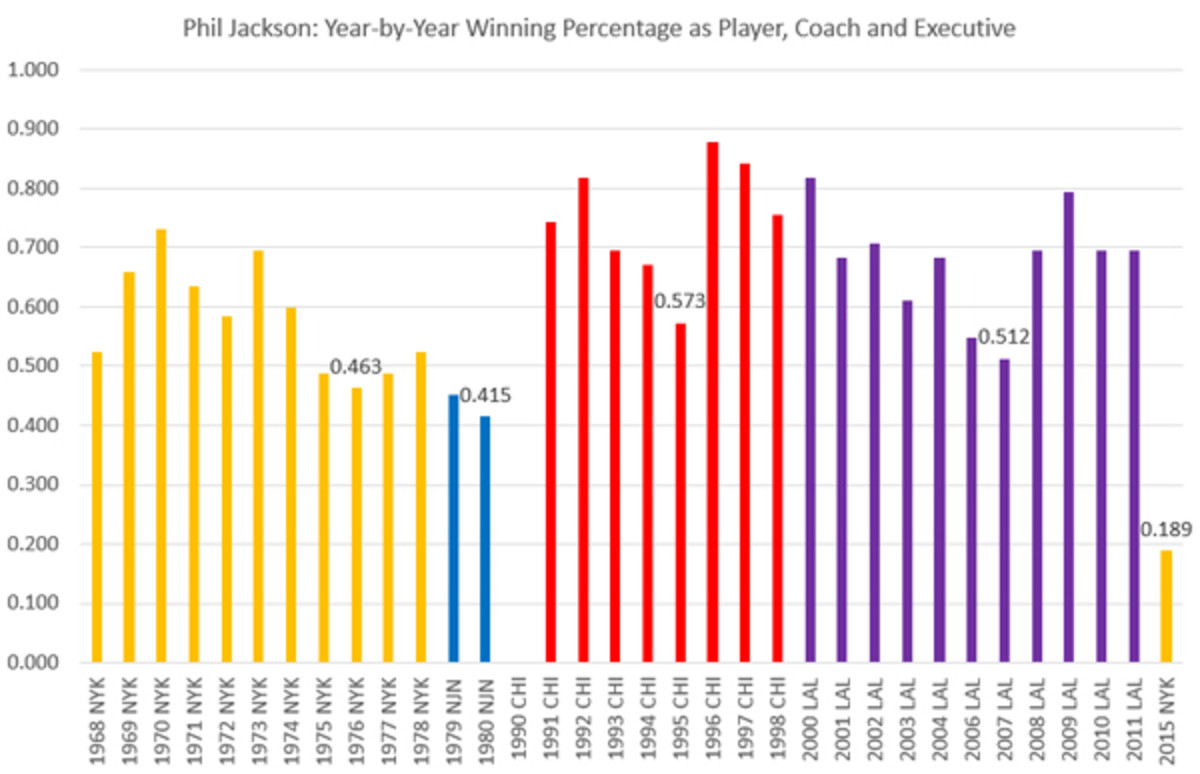
Click here for full size.
While nothing can or should change the basketball world's collective appreciation for the Zen Master's success with the Jordan Bulls and the Shaquille O'Neal/Kobe Bryant and Bryant/Pau Gasol Lakers, the mystique that has built around Jackson is bound to suffer the longer his rebuilding project takes to play out. Jackson's perceived invincibility is at risk precisely because he has so heavily cloaked himself in basketball philosophy. If Jackson can't get back to his winning ways, there will be two cold conclusions coming around the corner: 1) That his genius wasn't actually as unassailable as everyone thought, and/or 2) The game has passed him by.
That reputation hit is one of the unavoidable costs of losing like this.
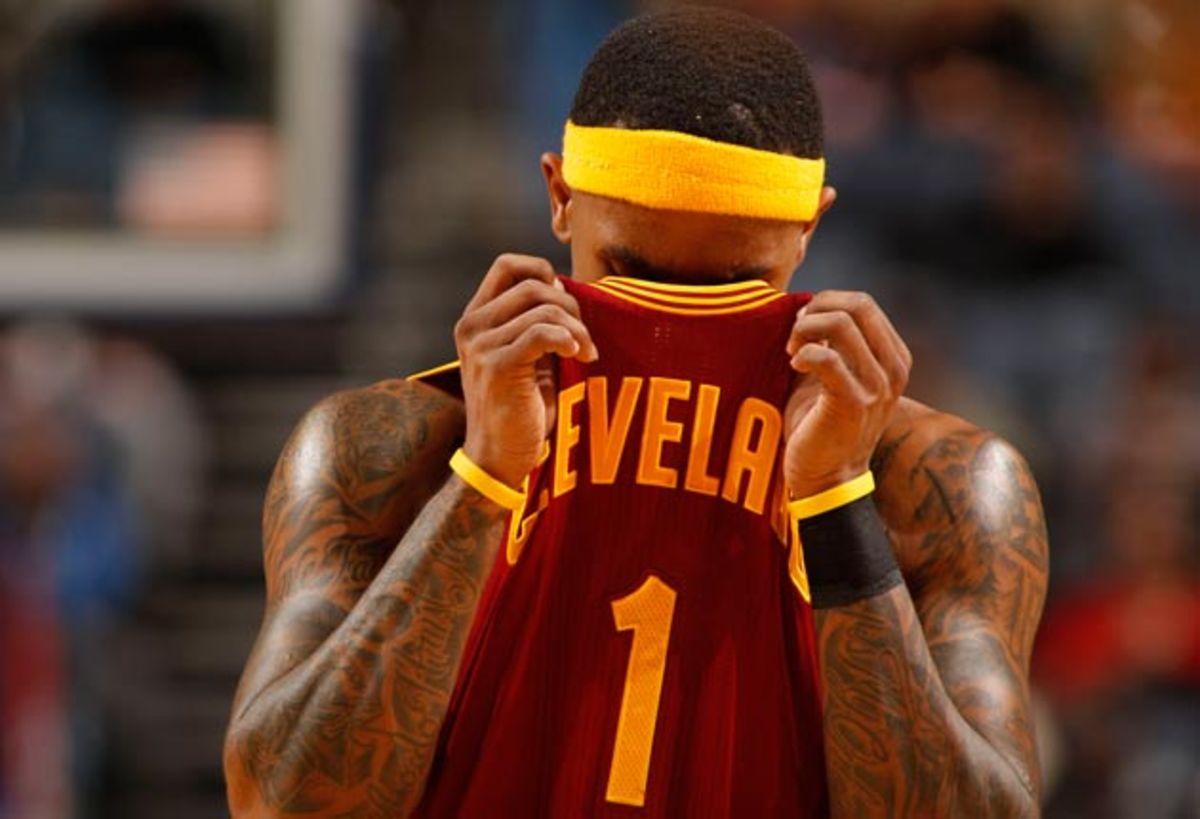
Light at the end of the tunnel?
As with any determined, long-term rebuilding plan, the time to accurately assess Jackson's front-office success won't come for years. The Chandler trade was a clear loss, but the Knicks president's decision to bail on a disappointing season and stack ping pong balls was the right call. Drastic change was needed: New York's season was already lost, the veteran pieces didn't fit Jackson's vision, the team's chemistry wasn't right, and the Knicks needed a significant talent infusion, the type that comes with a high lottery pick.
To get a feel for how this painful experiment might play out for New York, let's quickly look back at 10 of the worst post-ASW teams from the past 15 years to see how exactly they were rewarded in the lottery. This group includes teams that have enjoyed sustained success and sustained failure, and just about everything in between.
2001 Warriors: After a 17-65 season under Dave Cowens, the Warriors selected Jason Richardson with the No. 5 pick. The franchise didn't crack .500 until 2006-07, after rolling through Cowens, Brian Winters, Eric Musselman and Mike Montgomery to get to Don Nelson as coach. The 2007 playoffs produced Golden State's only playoff series victory of the decade after the 2000-01 season. Although he never made an All-Star Game, Richardson has enjoyed a long and productive career (17.1 PPG, 5 RPG, 2.7 APG) that's still going on.
2012 Bobcats: Charlotte's record-setting 7-59 campaign ended in depressing fashion, when New Orleans won the rights to the No. 1 pick and Anthony Davis. The Bobcats settled for impact defender Michael Kidd-Gilchrist at No. 2. Owner Michael Jordan replaced Paul Silas with Mike Dunlap as coach after the 2011-12 season and then quickly replaced Dunlap with Steve Clifford the next year. Clifford guided Charlotte to a first-round exit in the 2014 playoffs. Kidd-Gilchrist (10.9 PPG, 7.6 RPG) looks like a keeper.
2006 Blazers: Year One of the Nate McMillan era produced a 21-61 record. A flurry of 2006 draft day trades landed eventual All-Stars LaMarcus Aldridge and Brandon Roy, laying the foundation for a franchise revival. Injuries to Roy and 2007 No. 1 overall pick Greg Oden derailed Portland's title hopes under McMillan, but the Blazers steadily built into a playoff team, making first-round exits in 2009, 2010 and 2011. Finally, thanks in large part to Aldridge, the Blazers won a playoff series in 2014, marking the first time they had advanced since 2000.
2010 Timberwolves: Minnesota managed just 15 wins in its first season under coach Kurt Rambis, a longtime Jackson aide who is now on Fisher's staff in New York. Eventual All-Star Kevin Love started just 22 games in his second season and washout lottery pick Jonny Flynn wasn't quite capable of leading the way. The Timberwolves earned the No. 4 pick and promptly wasted their selection on Wesley Johnson, who lasted just two years in Minnesota and is now bouncing around on minimum deals. The Timberwolves have yet to crack .500, much less make the playoffs or win a series, since 2010.
2008 Clippers: Mike Dunleavy oversaw a team that went 19-63 after losing Elton Brand to an Achilles injury early in the season. At No. 7, the Clippers drafted shooting guard Eric Gordon, who went on to average 22.3 points in 2010-11 before serving as a key piece in the franchise's blockbuster trade for All-Star guard Chris Paul. The addition of Gordon wasn't enough to keep the 2009 Clippers from landing on this list as well (see below).
2008 Sonics: In their final season in Seattle before relocating to Oklahoma City, the Sonics turned over plenty of playing time to rookies Kevin Durant and Jeff Green. The result was a 20-62 season and the No. 4 pick, which GM Sam Presti used to select perennial All-Star guard Russell Westbrook. (Also that year, Presti used a pick acquired from Phoenix to draft and stash Serge Ibaka.) In 2009, Presti went on to add James Harden in the lottery, creating a core that would make the playoffs in 2010, win its first series in 2011, and go to the 2012 Finals. Green and Harden would be shipped out by trades, but the Durant/Westbrook pairing has stood the test of time, quickly generating a level of sustained success that coined the term "Thunder model" when referring to successful rebuilding.
2014 Sixers: Last year's Sixers were so bad that SI.com felt obliged to crank out this thinkpiece, which tried to construct a team of non-Sixers that would actually be bad enough to lose to these anonymous guys. Philadelphia finished 19-63 after GM Sam Hinkie traded away Evan Turner and Spencer Hawes for draft picks in midseason deals. That 26-game losing streak ultimately paid off with only the second-worst record and the No. 3 pick. After the Sixers missed out on both Andrew Wiggins and Jabari Parker, Hinkie selected injured center Joel Embiid, who has yet to suit up this season. Philadelphia used the 2014-15 season to add to its draft pick stockpile and to get 2013 lottery pick Nerlens Noel some seasoning.
2009 Clippers: Donald Sterling stuck by Dunleavy for another season, and a team with plenty of big-name players (Gordon, Baron Davis, Chris Kaman, Marcus Camby, and Zach Randolph, who arrived via midseason trade) won just 19 games. L.A. lucked into the 2008 No. 1 overall pick and Blake Griffin, doing well to avoid instant bust HasheemThabeet, who went second to Memphis. Griffin would miss his entire rookie season due to a knee injury, but he would later pair with Paul to form a sensational duo that totally transformed the franchise's fortunes. The Clippers are headed to the playoffs for the fourth straight year with the Paul/Griffin duo, having advanced twice while also setting a new franchise winning percentage record along the way.
2012 Cavaliers: Byron Scott's 21-win team was all kinds of depressing during the lockout-shortened 2011-12 season, even with rookie Kyrie Irving trying his best to keep a talent-deficient roster afloat. The 2012 draft saw Cleveland surprisingly take Dion Waiters at No. 4, before the likes of Damian Lillard, Andre Drummond and Harrison Barnes. That pick, coupled with other questionable lottery selections like Tristan Thompson and Anthony Bennett, seemed like it would leave the Cavaliers stuck in a long-term losing rut. Scott was fired in 2013, his successor Mike Brown lasted just one season, and the Cavaliers weren't coming close to sniffing .500 no matter how many draft lotteries they won in a row. Last summer, everything changed when LeBron James announced his return. This season, Cleveland is not only playoff-bound for the first time since James left in 2010, they are arguably the East's team to beat, with Irving riding shotgun to James.
2008 Heat: Miami has only missed the playoffs once since 2004, but they missed it badly with a 15-67 season in 2008. The second-half fall-off was easily explained: Shaquille O'Neal was dealt to Phoenix in a midseason trade and Dwyane Wade was shut down in March with a knee injury. Miami was jumped by Chicago for the rights to the No. 1 pick, causing them to miss out on Derrick Rose and settle for Michael Beasley. The Heat took "Be Easy" over the likes of Westbrook, Love, Brook Lopez and others. Within two years, Beasley was dumped to the Timberwolves to make room for the 2010 arrivals of James and Chris Bosh. The "Big 3" went on to make four consecutive Finals appearances and win two titles before disbanding last summer.
